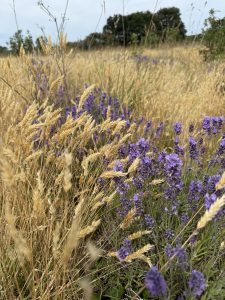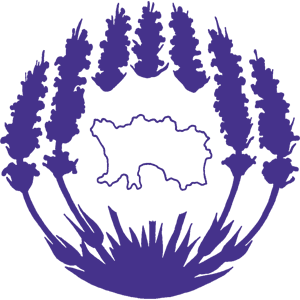
Traditionally 1st August is the first day of the harvest season, however we have been harvesting lavender since early to mid-July, to distil our essential oil for this year.
The hot weather brought on a beautiful display in the lavender fields and wild meadows, as you can see in contrast with the golden grasses. Truly a joy to behold. Lavender is an ancient beauty, prized for her fragrance and medicinal qualities for millennia. The Romans scattered her across stone floors, and stirred her into baths to cleanse body, mind and spirit. This is where her name comes from.
In medieval times, lavender pillows were filled with the heady aroma to banish bad dreams.
The flowers are also beloved by bees, and the air is filled with their buzzing, along with Peacock and Red Admiral butterflies dancing among the rows of lavender. Rabbits dart in and out of the sandy rows too, the natural sandy soil a boon for their digging of burrows!
I made lavender bags first as a child, and vividly recall my grandmothers harvesting the seeds for this purpose from their gardens. These time-served crafts are simple, yet so valuable for a healthy environment in the home.
Lavender tea, scones, shortbread and cakes are adored by many, but go easy on this powerful herb to flavour- it packs a punch! Less is more. You’ll find examples of these teatime delicacies in our café.
Her flowers grace us with their beauty for a relatively short time, the plants thriving in dry, seemingly barren soil. Soon the flowers are replaced by the hardy seeds, strong and holding the potent, volatile oils.
The distilled oil is bottled and put away to mature for a minimum of 6 months, it needs time to settle and develop the much-loved fragrance that so many of us love. Burned lavender has been used to clear spaces, brewed for a tea to ease the pain of grief, and oft used in rituals to bring peace, clarity and remembrance.
How do you enjoy lavender?
I’ve been infusing some in a sweet olive oil and also in alcohol for a tincture – both to be made into balms and creams with other herbs. The tincture will act as part of the water element necessary to make a gentle, yet highly effective, skin cream. Lavender oil is indicated where swelling is present, such as the inflammation from an insect bite or sting, a slightly infected scratch or graze, it is antimicrobial too.
Lavender and rosemary blend well together, a nice marriage of similar, but different herbs.
Will you be harvesting and saving your own lavender in some way…perhaps as a dried arrangement, or pot pourri?

